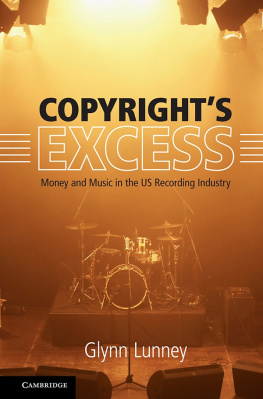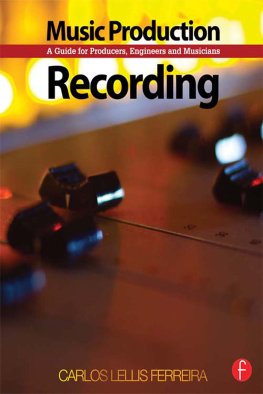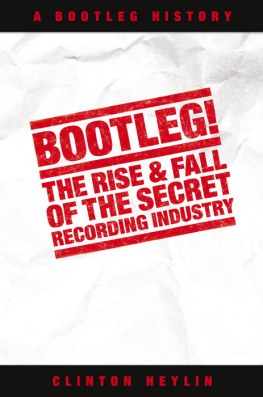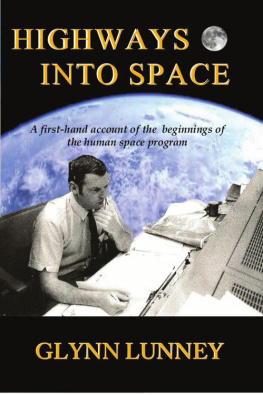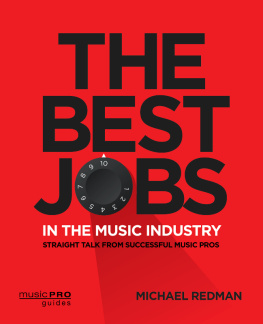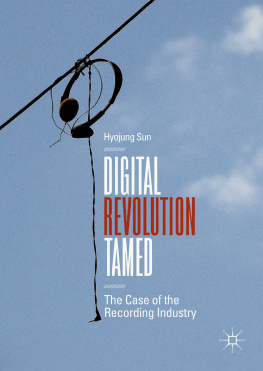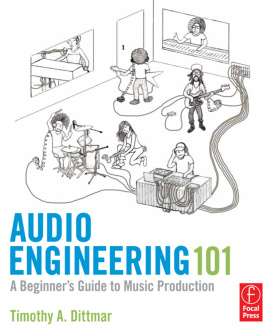Lunney - Copyright’s excess : money and music in the US recording industry
Here you can read online Lunney - Copyright’s excess : money and music in the US recording industry full text of the book (entire story) in english for free. Download pdf and epub, get meaning, cover and reviews about this ebook. City: United States., year: 2018, publisher: Cambridge University Press, genre: Politics. Description of the work, (preface) as well as reviews are available. Best literature library LitArk.com created for fans of good reading and offers a wide selection of genres:
Romance novel
Science fiction
Adventure
Detective
Science
History
Home and family
Prose
Art
Politics
Computer
Non-fiction
Religion
Business
Children
Humor
Choose a favorite category and find really read worthwhile books. Enjoy immersion in the world of imagination, feel the emotions of the characters or learn something new for yourself, make an fascinating discovery.
Copyright’s excess : money and music in the US recording industry: summary, description and annotation
We offer to read an annotation, description, summary or preface (depends on what the author of the book "Copyright’s excess : money and music in the US recording industry" wrote himself). If you haven't found the necessary information about the book — write in the comments, we will try to find it.
Lunney: author's other books
Who wrote Copyright’s excess : money and music in the US recording industry? Find out the surname, the name of the author of the book and a list of all author's works by series.
Copyright’s excess : money and music in the US recording industry — read online for free the complete book (whole text) full work
Below is the text of the book, divided by pages. System saving the place of the last page read, allows you to conveniently read the book "Copyright’s excess : money and music in the US recording industry" online for free, without having to search again every time where you left off. Put a bookmark, and you can go to the page where you finished reading at any time.
Font size:
Interval:
Bookmark:
Copyrights Excess
For more than 200 years, copyright in the United States has rested on a simple premise: more copyright will lead to more money for copyright owners, and more money will lead to more original works of authorship. In this important, illuminating book, Glynn Lunney tests that premise by tracking the rise and fall of the sound recording copyright from 1961 to 2015, along with the associated rise and fall in sales of recorded music. Far from supporting copyrights fundamental premise, the empirical evidence finds the exact opposite relationship: more revenue led to fewer and lower-quality hit songs. Lunneys breakthrough research shows that what copyright does is vastly increase the earnings of our most popular artists and songs Doing so reduced their productivity. At the same time, copyright did very little to increase the earnings of, and hence increase the productivity of, artists at the margins. The net result: more revenue was associated with the release of fewer hit songs. This book should be read by anyone interested in how copyright operates in the real world.
Glynn Lunney is a professor at Texas A&M University School of Law. He holds an engineering degree from Texas A&M, a law degree from Stanford, and a PhD in economics from Tulane. He is an internationally recognized scholar on copyright law and the economics of copyright. He has testified before Congress and appeared before the European Commission on copyright issues. Professor Lunney has published a casebook, Trademarks and Unfair Competition (2015), and has also published numerous articles in leading law reviews, including Stanford, Michigan, Virginia, Vanderbilt, Emory, and Boston universities.
Copyrights Excess
Money and Music in the US Recording Industry
Glynn Lunney
Texas A&M University School of Law


University Printing House, Cambridge CB2 8BS, United Kingdom
One Liberty Plaza, 20th Floor, New York, NY 10006, USA
477 Williamstown Road, Port Melbourne, VIC 3207, Australia
314321, 3rd Floor, Plot 3, Splendor Forum, Jasola District Centre, New Delhi 110025, India
79 Anson Road, #0604/06, Singapore 079906
Cambridge University Press is part of the University of Cambridge.
It furthers the Universitys mission by disseminating knowledge in the pursuit of education, learning, and research at the highest international levels of excellence.
www.cambridge.org
Information on this title: www.cambridge.org/9781107181670
DOI: 10.1017/9781316855140
Glynn Lunney 2018
This publication is in copyright. Subject to statutory exception and to the provisions of relevant collective licensing agreements, no reproduction of any part may take place without the written permission of Cambridge University Press.
First published 2018
Printed in the United States of America by Sheridan Books, Inc.
A catalogue record for this publication is available from the British Library.
Library of Congress Cataloging-in-Publication Data
Names : Lunney, Glynn, 1962- author.
Title : Copyrights excess : money and music in the US recording industry / Glynn Lunney.
Description : Cambridge, United Kingdom ; New York, NY : Cambridge University Press, 2018. | Includes bibliographical references and index.
Identifiers : LCCN 2017054437 | ISBN 9781107181670 (hardback : alk. paper) | ISBN 9781316632796 (pbk. : alk. paper)
Subjects : LCSH : CopyrightMusicUnited States. | MusicEconomic aspectsUnited States.
Classification : LCC ML 3790 . L 8 2018 | DDC 338.4/7780973dc23
LC record available at https://lccn.loc.gov/2017054437
ISBN 978-1-107-18167-0 Hardback
ISBN 978-1-316-63279-6 Paperback
Cambridge University Press has no responsibility for the persistence or accuracy of URLs for external or third-party internet websites referred to in this publication and does not guarantee that any content on such websites is, or will remain, accurate or appropriate.
For my parents
In the United States, Congress has the authority to enact copyright laws for a single purpose: to promote the Progress of on which copyright has been built.
For more than 300 years, we have steadily expanded the duration, scope, and reach of copyright based on this premise. Where the first United States copyright act, the Copyright Act of 1790, Throughout this expansion, the reasoning seems to be: if some incentives are good, more must be better.
Nevertheless, although we have justified and expanded copyright based on the fundamental premise that more incentives will yield more and better original works, we have never tested it. To be fair, there has been very little opportunity to test the connection between revenue and creative output. In most of the copyright industries over the last three hundred years, there has been a steady increase in both revenue and creative output, but whether this parallel rise reflects coincidence, causation, or something else entirely is difficult to determine. One copyright industry, however, has experienced a sharp rise, followed by an equally sharp fall, in revenue over the last fifty years: the music industry. In 1961, the Recording Industry Association of America (or RIAA) reported just under $4 billion (in constant 2013 dollars, or $2013) in sales of recorded music in the United States. From there, sales of recorded music rose, more or less steadily, to a peak in 1999 of just over $20 billion ($2013). That more or less steady rise in sales ended, however, in 1999 when Napster opened its virtual doors. Since then, with the rise of file sharing, sales of recorded music in the United States have fallen steadily. For the year 2014, sales fell below $7 billion ($2013) a level not seen, on an inflation-adjusted basis, since 1967.
This rise and fall provides us with a unique natural experiment and an important opportunity to test copyrights fundamental premise: for the recording industry, did the increase in revenue from 1962 to 1999 lead to increased creative output? Did decreased revenue from 2000 to 2015 lead to decreased creative output? If copyrights fundamental premise is true, then music output, both in terms of quantity and quality, should, all else being equal, have risen steadily from the 1960s until the end of the 1990s, and then should have begun a steady fall.
Moreover, this should be an easy test for copyrights fundamental premise to pass. The revenue change is not a slow, steady, and barely perceptible rise and fall,
When we look at various measures of the quantity and quality of popular new music released in the United States, we find that the exact opposite has been true. According to SoundScan, despite the decline in revenue, the number of new albums released in the United States in 2012, at 76,882, nearly doubled the number of new albums released in 1999, at 38,857. When Rolling Stone magazine ranked the 500 greatest albums of all time, the list skewed heavily toward albums released in the late 1960s and early 1970s, when the revenue from the sale of recorded music was low, not toward albums released in the late 1990s, when revenue was high. Turnover on the Billboard Hot 100 chart peaked in 1966, when 743 new songs were good enough to make the chart. From there, as revenues rose, chart turnover fell, reaching a nadir in 2002 when only 295 new songs were good enough to make the chart. Thereafter, as revenue fell with the rise of file sharing, chart turnover started increasing. In 2011, 497 new songs were good enough to make the Hot 100 chart a level not seen since the mid-1970s. If we use Spotify worldwide play counts in 2014, and treat long-term playability as a measure of or proxy for music output in terms of both quantity and quality, we find no evidence that more money led to more and better music. Spotify consumers in 2014 did not, for example, disproportionately stream songs from the high-revenue 1990s, compared to the lower-revenue 1960s or 1980s. For each of these measures, there was either no statistically significant correlation between revenue and output, or the correlation was statistically significant and negative. Less money led to more and better music.
Font size:
Interval:
Bookmark:
Similar books «Copyright’s excess : money and music in the US recording industry»
Look at similar books to Copyright’s excess : money and music in the US recording industry. We have selected literature similar in name and meaning in the hope of providing readers with more options to find new, interesting, not yet read works.
Discussion, reviews of the book Copyright’s excess : money and music in the US recording industry and just readers' own opinions. Leave your comments, write what you think about the work, its meaning or the main characters. Specify what exactly you liked and what you didn't like, and why you think so.

